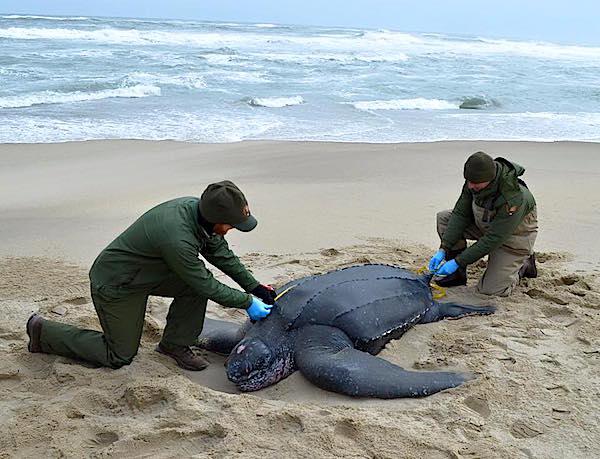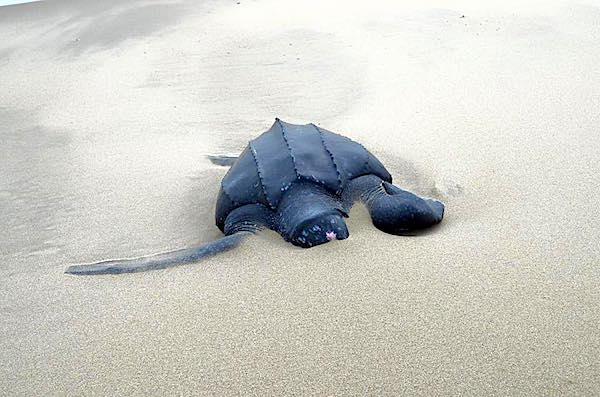
This leatherback sea turtle was spotted at Cape Hatteras on Friday/NPS
Editor's note: This updates with initial findings from a necropsy conducted on the turtle conducted by North Carolina State University's Center for Marine Sciences and Technology.
An obviously ailing leatherback sea turtle discovered on a beach at Cape Hatteras National Seashore in North Carolina had to be put down, due to the unlikelihood that it would survive in captivity and was too sick to be released back into the Atlantic Ocean. Initial results from a necropy indicated she had ingested plastic, had been bitten by a shark, and had been "scavenged" by sea gulls.
The turtle was spotted Friday on a beach near Rodanthe. According to park officials, "This species of sea turtle is rare in Cape Hatteras National Seashore, but as of late (since 2012) there have been an average of one per year. Sadly, all sightings have had unfavorable outcomes. They usually strand alive, with plastic found in the gastrointestinal tract in every case."
In this case, the "turtle was extremely lethargic and its head was buried in sand'from the 20+ mph winds'when the biologists arrived," a post on the park's Facebook page said. "The veterinarian deemed the female sea turtle un-releasable, and the size of these animals do not make them good candidates for rehabilitation (706 lbs!). Euthanasia was the only option, after which the turtle was transferred to the Center for Marine Sciences and Technology (CMAST) in Morehead City for a thorough necropsy."
Leatherback sea turtles prey upon jellyfish, seashore biologists said, and can easily mistake a floating piece of plastic as food'a fatal mistake. By responsibly disposing of plastic and picking up any discarded trash, you might help spare more sea turtles from this fate.
"Scavenging gulls had damaged both eyes before they were buried by sand, and she had sustained one small shark bite," the CMAST veterinarians who examined her said. "Like with all other leatherback sea turtles examined postmortem by CMAST investigators, this one contained plastic in her GI tract. She also had evidence of forced submergence."
Further tests, including some to search for toxins in her tissues, were being conducted to try and answer why the turtle stranded herself on the beach.

When found, the turtle's head was buried in the sand/NPS



Comments
Keep those photos in mind the next time you start to pack something on the way to a beach in a plastic bag.
Good point, Rudy, and much of the plastic in the water originates inland. "Eighty percent of the plastic debris comes from land. It washes out to sea from our beaches, streets and highways. It flows out through storm drains into streams and rivers. It flies away from landfills..."
This report from the Woods Hole Oceanographic Institution notes, "when plastic reaches our waters, whether it be plastic bags or drifting fish nets, it poses a threat to the animals that depend on the oceans for food. To a sea turtle, a floating plastic bag looks like a jellyfish. And plastic pellets--the small hard pieces of plastic from which plastic products are made--look like fish eggs to seabirds...."
This, from the National Institutes of Health, notes, "..., plastics are now one of the most common and persistent pollutants in ocean waters and beaches worldwide...Between 1970 and 2003, plastics became the fastest growing segment of the US municipal waste stream, increasing nine-fold, and marine litter is now 60-80% plastic, reaching 90-95% in some areas. While undoubtedly still an eyesore, plastic debris today is having significant harmful effects on marine biota...."
Are plastic products convenient? No doubt. Are far too many people unwilling to dispose of them propertly? Sadly, yes.